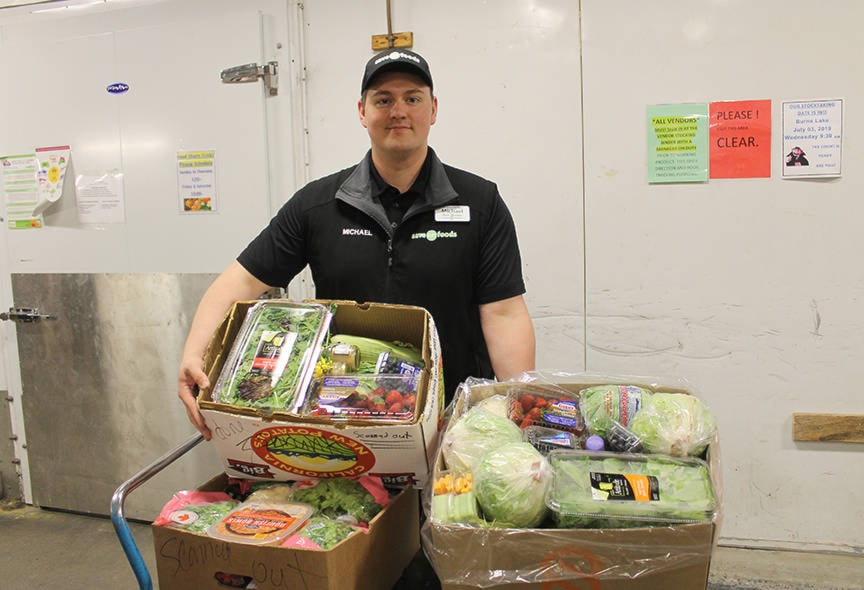The local Save-On-Foods in Burns Lake is among most of the supermarket chain’s stores to boast 100 per cent reduction of food waste.
In an early June press release, Save-On-Foods said that 86 of its stores are “now diverting 100 per cent of their unsalable perishable food from landfills.”
The chain has more than 150 stores from Manitoba west to British Columbia, and in the Yukon.
“Save-On-Foods has surpassed its company-wide goal of cutting its food waste in half by the year 2025 – a goal it announced only six months ago,” the release said.
The Burns Lake branch has been working on eliminating food waste for several years. Food that has passed its expiry date but is still fit for human consumption is donated to The Link Food Centre, formerly known as the Lakes District Food Bank. Items that aren’t edible are passed onto the Loop Resource and sent to local farms for animals to eat.
As recently as March, Save-On-Foods’ efforts were succeeding in reducing waste by up to 90 per cent, as assistant store manager Jared Obermeyer told Lakes District News.
LOOK BACK: Stores join with community to end food waste
The same success has been noted elsewhere in B.C., including at a Save-On location in Chilliwack.
READ MORE: ‘Game-changing’ program to combat food waste to expand across B.C.
In the three months since then, the Burns Lake store has closed the gap by carefully organizing its unsold food inventories.
“We try to keep on top of the items that we shrink [wrap] out every single day. Keeping that under control and making sure that when our two different opportunities for pickup of those items comes in, that we have as much product for them as we can for that date,” explained acting manager Kevin Wiebe.
“And full commitment by all of our departments to make this a reality.”
Wiebe added that the store has been donating to the Food Share Program for three or four years, long before a specific waste reduction initiative was set by Save-On-Foods’ head office. Food Share was started in 2014 by Jennifer Petersen, of Lakes Literacy. The branch began working with the Loop Resource last summer during the wildfires.
Jaime White, director of the Loop Resource said he’s thrilled at the news of waste reduction at 86 locations.
“Sixty-three of those [stores] are with Loop. This is a relationship that has borne a lot of fruit for everyone involved, for the charities and the stores. We hope that their leadership in this spills over to other brands. We believe that no food should be in the garbage in this day and age,” White said.
The Loop Resource started in 2016 from White’s farm in Dawson Creek. Today it supplies donated food to 1,100 farms in B.C., Alberta, Saskatchewan, parts of Manitoba and in the Yukon.
Save-On-Foods is “a larger company that thinks like a smaller company”, White said, and its ability to make fast, values-based decisions has helped it achieve its waste reduction targets.
White is particularly appreciative of the role Candice Little, Coordinator at the Link Food Centre has played in working with the Loop.
“They’ve been a Loop partner for a long time on the farm front and she’s taken a leadership position to find more ways to divert more of this [food] to people. It’s a fantastic credit to the community.”
In the five years that Little has been managing the food bank, its partnership with Save-On-Foods has grown to the point where today, the Link makes a daily pickup at 4 p.m.
“We take all food fit for human consumption. We sort through it and refrigerate what we need to. everything not fit for human consumption goes out to the Loop,” she said.
The Link and the Loop distribute donations based on the needs hierarchy of humans first, animals second and compost third, and ideally nothing going to the garbage dump.
The coordinator began to notice that some of the food destined for the Loop was still edible, so the Link has become a kind of clearing house for both its own supplies and for the Loop.
“Our first commitment is keep it simple for the store. And we don’t want the farmer running all over town. It’s a one-stop shop so they only make one stop that day. So then we can move it out to whoever needs it,” Little said.
“I’m confident we can get better at what we’re doing. I think it’s awesome that Save-On is helping across the province. It’s definitely the wave of the future. We don’t need any more food in the landfills and we need more in peoples’ bellies.”
Blair McBride
Multimedia reporter
Send Blair an email
Like Lakes District News on Facebook
